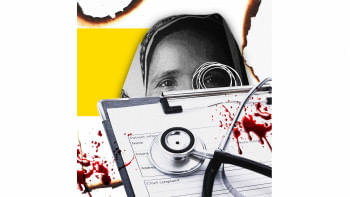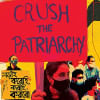What’s wrong with how we report on violence against women?

A news report on the economy without any insight from an economist, or the experiences of someone struggling with the cost-of-living crisis. An article on the energy crisis, but not one energy expert weighs in. An exposé on farmers being cheated out of decent prices by middlemen, but farmers' voices are completely absent.
Would you, as a reader, find these pieces worth reading? Would journalists and editors consider this good practice?
The answer, I believe, would be an emphatic no. Yet, when it comes to reporting on gender-based violence (GBV), print media in Bangladesh routinely excludes expert opinions and female sources.
By doing so—and by following a set reporting formula that focuses on the minute details of isolated crimes, erases survivors' trauma and ignores wider inequalities that create the conditions for violence against women—we are failing to represent the true extent of gender-based violence in our society.
This was one of the findings from research I conducted last year, where I went through reports from four major newspapers in Bangladesh related to three widely-reported cases of rape in 2020, when anti-rape protests took the country by storm.
This movement not only demanded accountability from state authorities, but questioned a system and society that normalised violence. Trauma, and its impacts on individuals, families and communities, was at the heart of this story.
Is our reporting gender-sensitive?
In the 258 reports that I did a content analysis on, the focus was mainly on the minute details of the crime committed against the woman, with hardly any reflection of her trauma and her resilience. The factors in our society and their institutions that allow gender-based violence to become normalised were largely absent as well.
Thirty-six percent of the reports held sensationalist and provocative details that failed to uphold the dignity of survivors, such as describing again and again the different objects used to gang-rape a woman. Almost half the reports erased the survivor from the narrative, focusing more on perpetrators and quotes from police and political leaders (usually male).
Less than a quarter held quotes from women's rights activists and GBV experts, and a whopping 66 percent of reports had no female sources. Overall, more than 68 percent of reports failed to highlight GBV as a human rights issue that requires serious policy intervention, choosing to focus on the individual circumstances of the cases instead.
Why is this important?
Academics argue one of the functions of media is the creation of a "realm of shared experience". Simply put, how media reports on issues is significant to how people ultimately understand them. This includes policymakers, to whom media coverage can act as a guide to what issues are of public concern.
Through its interpretive authority, media can reflect, shape and challenge public discourse. And if the media narrative is—explicitly or implicitly—biased against women, and if women are invisible in reports that are actually meant to be about women, then media simply ends up reproducing gender inequalities and normalising the very injustices they report on.
Across the world, male-dominated newsrooms mean that gender-based violence and gender inequality are massively underreported. According to the Global Media Monitoring Project (GMMP), the most severe underrepresentation occurs in newspapers, and even when these reports are written, seven to nine out of every 10 stories end up reinforcing or failing to challenge gender stereotypes. Because of this, GBV is regularly put in a box with other crimes, with little acknowledgement of how it routinely occurs in a system defined by gender inequality.
Gender bias in Bangladeshi media
Such stereotypes and biases are reproduced in Bangladeshi media as well. For example, while I found that almost 90 percent of media reports did not directly engage in victim-blaming, around 36 percent used "victim v monster" stereotypes when talking about survivors and perpetrators of rape.
While the idea might be to strike a sympathetic tone, this can lead to the woman being portrayed as someone who has been "ruined" by abuse, not as an individual deserving of empathy. Who journalists decide is the ideal victim leads to a number of problematic associations as well, with "respectable" and "unlikely" victims getting more space than survivors from marginalised backgrounds.
We saw this happen during the Kurmitola case, where the survivor—a middle class, university student from the capital—was surprisingly present in newspaper narratives. Even though her trauma was not acknowledged directly, there were some attempts to humanise her through reports on her determination to return to her studies, or her courage in helping the police.
However, reporters completely failed to follow-up on police information on how the rapist had previously raped other homeless and disabled women who did not fit the mould of this "ideal" victim. Also, the unfortunate flip side of the focus on the Kurmitola survivor was that reports ended up including a lot of unnecessary personal information, such as what items of clothing were found at the crime scene.
Victim/monster stereotypes also end up portraying rape as being related to deviant sexual behaviour and bad habits, instead of as an abuse of power and an exercise in misogyny. The presumption is that the rapist is somehow an outlier or anomaly in society and not a product of the unequal power structures that lead to gender-based violence. As we witnessed in the case of the Banani rape trial, and with relation to the Munia murder, perpetrators belonging to the upper classes and from "good families" are treated completely differently in the media than working class perpetrators.
The voices reflected in our reports, matter
A lot of the times, the gender biases being reproduced in the media stem from the male-dominated institutions that are routinely cited in reports. Research suggests that state representatives, political actors and even ordinary citizen' voices tend to marginalise women's agency in reports, whereas experts on women's rights, such as feminist lawyers, activists and journalists, are far more likely to focus on women's agency and wider issues surrounding sexual violence.
This is not to say that only women can speak on issues related to GBV. In fact, women's rights activists have questioned why many male activists are vocal in the media about human rights abuses like enforced disappearances and custodial torture, but fail to make the country's high rate of GBV part of the public human rights agenda as well.
The concern, rather, is over a lack of inclusivity and diversity in the voices featured in news reports, which ultimately affects news quality and objectivity. GMMP data also suggests that the underrepresentation of women journalists and editors is an important factor in the erasure of female voices in reporting, and of gender-sensitive news judgement in general.
We see this in the Bangladeshi context too. News reports routinely quote the police without interrogating their statements, even if they are biased and gender-insensitive. For example, the Kurmitola rapist turned out to be a homeless man with a history of drug addiction and, during that period, police representatives routinely made comments linking drug use with sexual deviancy. This narrative was reproduced without question in a number of reports, ultimately erasing the fact that sexual violence is committed by persons from all sections of society, and not just homeless drug addicts.
Reporters I interviewed also spoke of consulting police reports to write their stories, even though they all agreed they tend to be filled with insensitive comments, graphic descriptions, and sometimes even incorrect information. However, very few then went on to ask the police specific questions that identified the individual case as part of systemic violence against women.
Survivors' medical reports from one-stop crisis centres, which one journalist described as being filled with "excruciating, biological details", are also used when writing news reports. Information related to DNA evidence and injury marks are routinely found in print, even though experts argue that sharing such evidence (or lack thereof) can mislead the public and inspire public conversations that put survivors on trial.
These are just a few examples of the different ways in which patriarchal notions are reproduced in newsrooms, distracting from wider, systemic issues related to GBV that can inspire more meaningful conversations, such as gender biases in the justice system, policy decisions affecting gender equality, social stigma, etc.
We must change how we report
There are a number of ways that journalists can choose to make their reports more gender-sensitive. During my research, I noticed an interesting trend. While the images used with GBV reports had previously been triggering—referring to the act of rape in some way, such as by depicting a woman with her hands tied or shrinking from a male figure—84 percent of reports printed during the anti-rape movement pictured the protests instead. This included women holding up placards with sayings such as "men put your gaze in jail" and "only a rapist is responsible for rape."
While this was a positive change, unfortunately, most of the actual reports ignored these themes. Almost all quotes related to protests were from male demonstrators, mostly leaders of student bodies affiliated with political groups. Many of them referred to women as their "mothers" and "sisters", and used other patriarchal and often victimising language. So, while images became more sensitive, there was clearly a crucial gap in reporting.
It is clear that the way we are talking about violence against women is not working. In fact, it is likely that this overdose of the same story being rehashed—with an excessive focus on individual details of crimes and little to no acknowledgement of survivors' trauma and the systemic nature of GBV—is leading to a sense of hopelessness about a society where violence is the norm. Even if the intention is to tell readers about this violence, ultimately, all this does is create media fatigue.
The first step in dealing with this is changing how we talk about violence. Reporters need to be trained to use gender-sensitive language, print information outside of police and medical reports, speak to experts on GBV trends, and employ a big-picture narrative to address the whole cycle of violence, from prevention to prosecution.
While the 2020 anti-rape protests had momentum, print media did focus on the justice system, measures taken by law enforcement and government responsibility when reporting on rape. We need to continue this, as well as write on wider issues such as social stigma, health consequences of sexual violence, and the power structures that allow rape to be committed with impunity.
We need awareness at every level of the media, starting from decision-makers to consumers, but beyond that, what we desperately need is diversity. While I am in no way arguing that only women can tell women's stories—in fact, that too is a gender stereotype that obstructs female reporters from writing on what many (wrongly) consider to be "masculine" topics, like sports and politics—we cannot ignore the fact that only around 11 percent of reporters in Bangladesh are female, and there are very few women in decision-making positions in our industry.
This lack of representation, not just of women, but other minorities in the industry, is bound to lead to media biases. If we acknowledge these biases and aim to introduce reporting practices that are trauma-informed and centred on survivors, this will not only advance gender justice, but lead to better journalism as well.
Shuprova Tasneem is a journalist.

 For all latest news, follow The Daily Star's Google News channel.
For all latest news, follow The Daily Star's Google News channel. 









Comments